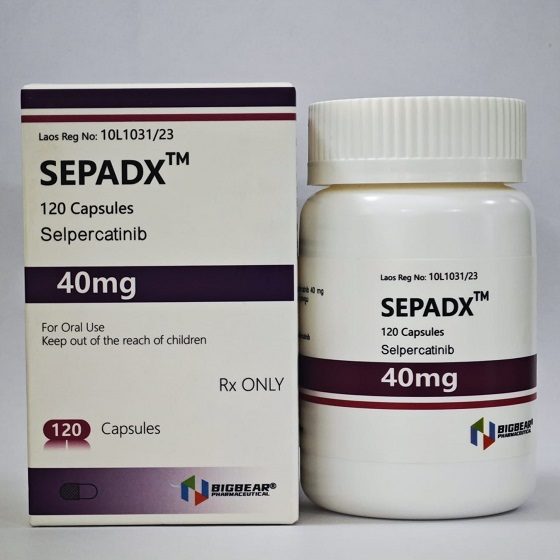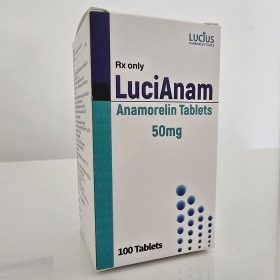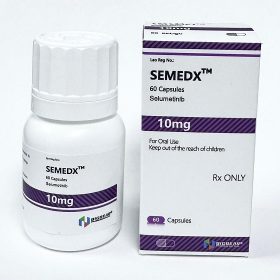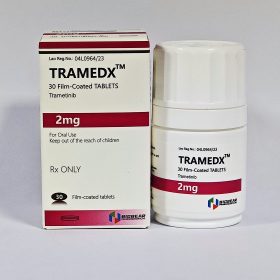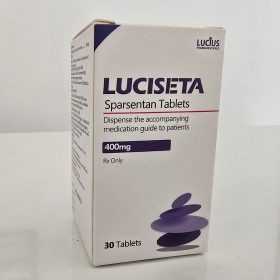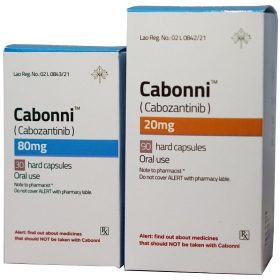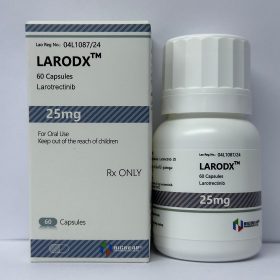- Details
- Description
-
Packaging Size120c
-
Strength40mg
-
CompositonSelpercatinib
-
TreatmentRET-Positive Lung Cancer,RET-Positive Medullary Thyroid Cancer
-
FormCapsule
-
BrandSEPADX
-
Quantity Unit40mg*120c/Box
-
ManufacturerBIGBEAR Pharma,Laos PDR
The targeted drug selpercatinib has been a treatment option for some people with lung cancer or thyroid cancer whose tumors contain specific changes in a gene called RET.
Non-small Cell Lung Cancer
Indicated for metastatic RET fusion-positive non-small cell lung cancer (NSCLC)
<50 kg: 120 mg PO BID
≥50 kg: 160 mg PO BID
Continue until disease progression or unacceptable toxicity
Medullary Thyroid Cancer
Indicated for advanced or metastatic RET-mutant medullary thyroid cancer (MTC) in patients who required systemic therapy
<50 kg: 120 mg PO BID
≥50 kg: 160 mg PO BID
Continue until disease progression or unacceptable toxicity
Thyroid Cancer
Indicated for advanced or metastatic RET fusion-positive thyroid cancer in patients who require systemic therapy and who are radioactive iodine-refractory (if radioactive iodine is appropriate)
<50 kg: 120 mg PO BID
≥50 kg: 160 mg PO BID
Continue until disease progression or unacceptable toxicity
Other RET Fusion-Positive Solid Tumors
Indicated for locally advanced or metastatic solid tumors with a RET gene fusion that have progressed on or following prior systemic treatment or who have no satisfactory alternative treatment options
<50 kg: 120 mg PO BID
≥50 kg: 160 mg PO BID
Continue until disease progression or unacceptable toxicity
Dosage Modifications
Dose reduction recommendations
-
Weight <50 kg
- First reduction: 80 mg BID
- Second reduction: 40 mg BID
- Third reduction: 40 mg qDay
- Permanently discontinue if unable to tolerate third dose reduction
-
Weight ≥50 kg
- First reduction: 120 mg BID
- Second reduction: 80 mg BID
- Third reduction: 40 mg BID
- Permanently discontinue if unable to tolerate third dose reduction
Hepatotoxicity grade 3 or 4
- Withhold dosing and monitor AST/ALT once weekly until resolution to Grade 1 or baseline
- Resume at reduced dose by 2 dose levels and monitor AST/ALT once weekly until 4 weeks after reaching dose taken prior to the onset of Grade 3 or 4 increased AST or ALT
- Increase dose by 1 dose level after a minimum of 2 weeks without recurrence, and then increase to dose taken before Grade 3 or 4 increased AST or ALT after minimum of 4 weeks without recurrence
Interstitial lung disease/ pneumonitis
- Grade 2: Withhold until resolution; resume at a reduced dose; discontinue for recurrent ILD/pneumonitis
- Grade 3 or 4: Discontinue for confirmed ILD/pneumonitis
Hypothyroidism
- Grade 3 or 4: Withhold until resolution to Grade 1 or baseline; discontinue based on severity
Hypertension
- Grade 3: Withhold dosing for Grade 3 hypertension that persists despite optimal antihypertensive therapy; resume at reduced dose when hypertension controlled
- Grade 4: Discontinue
QT prolongation
- Grade 3: Withhold dosing until recovery to baseline or Grade ≤1; resume at reduced dose
- Grade 4: Discontinue
Hemorrhagic events grade 3 or 4
- Withhold dosing until recovery to baseline or Grade ≤1
- Discontinue for severe or life-threatening hemorrhagic events
Hypersensitivity reactions all grades
- Withhold dosing until resolution; initiate corticosteroids
- Resume at reduced dose by 3 dose levels while continuing corticosteroids
- Increase dose by 1 dose level each week until the dose taken prior to hypersensitivity event is reached, then taper corticosteroids
Other adverse effects grade 3 or 4
- Withhold dosing until recovery to baseline or Grade ≤1
- Resume at reduced dose
Coadministration with CYP3A inhibitors
- Avoid coadministration; if unable to avoid, reduce selpercatinib dose
- After inhibitor has been discontinued for 3-5 elimination half-lives, resume selpercatinib at dose take prior to initiated the CYP3A inhibitor
-
Moderate CYP3A inhibitor
- If current dose is 120 mg BID, reduce to 80 mg BID
- If current dose is 160 mg BID, reduce to 120 mg BID
-
Strong CYP3A inhibitor
- If current dose is 120 mg BID, reduce to 40 mg BID
- If current dose is 160 mg BID, reduce to 80 mg BID
Renal impairment
- Mild-to-severe (CrCl ≥15 mL/min): No dose adjustment required
- ESRD: Recommended dose not established
Hepatic impairment
-
Mild or moderate
- No dose adjustment required
- Mild defined as: TB ≤ULN with AST >ULN OR TB >1-1.5x ULN with any AST
- Moderate defined as: TB >1.5-3x ULN with any AST
-
Severe
- If current dose is 120 mg or 160 mg BID, reduce to 80 mg BID
- Severe defined as: Total biliruvin (TB) >3-10x ULN with any AST
Acid-reducing agents
Avoid with PPIs, histamine-2 (H2) receptor antagonists, or locally acting antacids
-
If unable to avoid
- PPIs: Take with food when coadministered
- H2 receptor antagonist: Take selpercatinib 2 hr before or 10 hr after an H2 antagonist
- Locally acting antacid: Take selpercatinib 2 hr before or 2 hr after antacid
Dosing Considerations
Select patients for treatment based on presence of RET gene fusion (NSCLC or thyroid cancer) or specific RET gene mutation (MTC) in tumor specimens or plasma

